Reports
Provided below is a listing in reverse chronological order of NP-sponsored workshop reports that address the status of some important research areas.
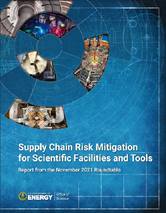 |
Supply Chain Risk Mitigation for Scientific Facilities and ToolsIn November 2021, the U.S. Department of Energy (DOE) Office of Science (SC) convened a roundtable on “Supply Chain Risk Mitigation for Scientific Facilities and Tools” to gather information about current supply chain challenges in key technology areas unique to SC or critical to its mission. The roundtable brought together technical, project management, and procurement experts from DOE national laboratories, industry, academia, and other government agencies. Panelists explored opportunities, possible partnerships, and mechanisms to strengthen the domestic supply chain for critical SC technologies. |
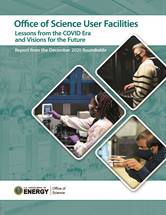 |
Office of Science User Facilities Lessons from the COVID Era and Visions for the FutureDuring the COVID-19 pandemic, Office of Science user facilities responded with innovations that modified many operations to create safe working conditions for staff while providing support for users and enabling facilities’ science programs to continue. To capture lessons learned, the Office of Science convened facility staff, user executive committee chairs, and users from across its user facilities in a virtual roundtable. This report summarizes the roundtable findings and identifies opportunities to provide even stronger, more resilient, and more enabling user facilities in the future, encompassing topics including user research and facility operations in virtual and physically distanced contexts; user training and engagement; computation, data, and network resources; and crosscutting issues. |
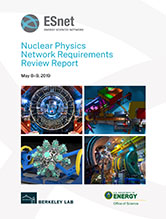 |
Requirements Review Purpose and ProcessESnet and ASCR utilize requirements reviews to discuss and analyze current and planned science use cases and anticipated data output of a particular program, user facility, or project to inform ESnet’s strategic planning, including network operations, capacity upgrades, and other service investments. A review surveys major stakeholders’ plans and processes in order to investigate data management requirements over the next 5–10 years. Questions crafted to explore this space include:
|
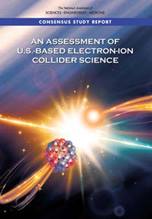 |
An Assessment of U.S. Based Electron-Ion Collider Science, September 2018The Committee on U.S.-Based Electron-Ion Collider Science Assessment was asked by the Department of Energy (DOE), in its statement of task, to assess the scientific justification for a U.S. domestic electron-ion collider (EIC) facility and to evaluate the importance and urgency of the science that an EIC would address to both nuclear science and the physical sciences more broadly. The committee’s task also included assessing the role of an EIC in the global context, including its relationship to other facilities within the United States and around the world. Lastly, the committee was asked to assess the broader impacts of an EIC, including on U.S. science leadership. The full statement of task is included in Appendix A. In summary, the committee finds a compelling scientific case for such a facility. The science questions that an EIC will answer are central to completing an understanding of atoms as well as being integral to the agenda of nuclear physics today. In addition, the development of an EIC would advance accelerator science and technology in nuclear science; it would also benefit other fields of accelerator- based science and society, from medicine through materials science to elementary particle physics. |
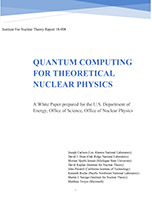 |
Quantum Computing for Theoretical Nuclear Physics, February 2018Tremendous excitement exists among quantum computing enthusiasts as we witness the rapid evolution of quantum computing devices toward early practical implementation. Importantly, algorithm developments suggest that qubit devices have the potential to solve quantum many-body and quantum field theory problems of relevance to various research directions within the Department of Energy Office of Science and National Science Foundation. While exascale platforms represent the current horizon of excellence in computing, quantum computing provides the technology that lies beyond this horizon and opens the door to new vistas of theoretical endeavor. During a recent workshop at the Institute for Nuclear Theory, a group of 39 scientists from academia, government, national laboratories, and industry gathered to discuss the future of quantum computing for nuclear physics. Researchers described the basic scientific challenges in quantum chromodynamics and quantum many body problems that could be addressed utilizing the power of quantum computing in the future. The group also discussed mechanisms for developing quantum-computing algorithms specifically for nuclear physics applications. This White Paper provides a synopsis of the workshop discussions, and suggests possible activities that might be supported as part of a vibrant pilot program of nuclear physics research in this area. |
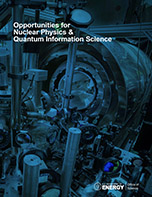 |
Opportunities for Nuclear Physics & Quantum Information ScienceThis whitepaper is an outcome of the workshop Intersections between Nuclear Physics and Quantum Information held at Argonne National Laboratory on 28–30 March 2018 [www.phy.anl.gov/npqi2018/]. The workshop brought together 116 national and international experts in nuclear physics and quantum information science to explore opportunities for the two fields to collaborate on topics of interest to the U.S. Department of Energy (DOE) Office of Science, Office of Nuclear Physics, and more broadly to U.S. society and industry. The workshop consisted of 22 invited and 10 contributed talks, as well as three panel discussion sessions. Topics discussed included quantum computation, quantum simulation, quantum sensing, nuclear physics detectors, nuclear many-body problem, entanglement at collider energies, and lattice gauge theories. |
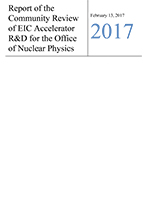 |
NP Community Panel Report on Electron Ion Collider (EIC) Accelerator R&D, February 2017An NP community panel, chaired by Dr. Kevin Jones of Oak Ridge National Laboratory, was charged by the Office of Nuclear Physics to provide guidance on the current status of accelerator R&D efforts and the priorities for future accelerator R&D that will enable an EIC pre-conceptual design. This design should deliver the EIC scientific objectives, while simultaneously minimizing technical risk and promoting cost effectiveness. This panel met on November 29-December 2, 2016 in the Washington DC area with presentations on the current EIC technical design concepts and R&D activities from the NP community. The report here describes the panel evaluation of the current status of accelerator R&D, proposed EIC concepts and their technical feasibility, and a list of R&D priorities for each EIC concept. PDF file of this report |
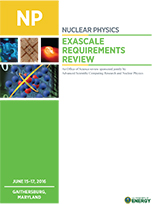 |
NP EXASCALE REQUIREMENTS REVIEW, JUNE 15–17, 2016Imagine being able to predict — with unprecedented accuracy and precision — the structure of the proton and neutron, and the forces between them, directly from the dynamics of quarks and gluons, and then using this information in calculations of the structure and reactions of atomic nuclei and of the properties of dense neutron stars (NSs). Also imagine discovering new and exotic states of matter, and new laws of nature, by being able to collect more experimental data than we dream possible today, analyzing it in real time to feed back into an experiment, and curating the data with full tracking capabilities and with fully distributed data mining capabilities. Making this vision a reality would improve basic scientific understanding, enabling us to precisely calculate, for example, the spectrum of gravity waves emitted during NS coalescence, and would have important societal applications in nuclear energy research, stockpile stewardship, and other areas. This review presents the components and characteristics of the exascale computing ecosystems necessary to realize this vision. |
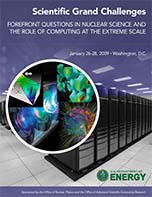 |
Scientific Grand Challenges
|
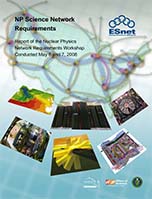 |
NP Science Network Requirements
|
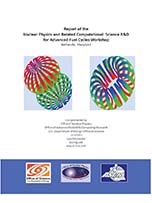 |
Report of the Nuclear Physics and Related Computational Science R&D for Advanced Fuel Cycles Workshop
|
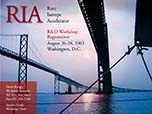 |
Report of the 2003 RIA R&D Workshop
|
 |
Report on the Workshop on the Role of Nuclear Physics Research Community in Combating Terrorism
|



